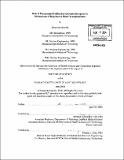Role of peroxisome proliferator-activated receptors in mechanisms of rejection in heart transplantation
Author(s)
Binello, Emanuela
DownloadFull printable version (13.71Mb)
Other Contributors
Harvard University--MIT Division of Health Sciences and Technology.
Advisor
Richard N. Mitchell.
Terms of use
Metadata
Show full item recordAbstract
Peroxisome proliferator-activated receptors (PPARs) belong to a nuclear receptor superfamily; two major isoforms, PPARα and PPAR[gamma], are primarily involved in lipid and glucose homeostasis. However, evidence also suggests roles for PPARs in regulating inflammation and atherosclerosis, and prompted investigation into the efficacy of PPAR agonists in parenchymal rejection (PR) and transplantation-associated arteriosclerosis (TxAA). Four different PPAR agonists (fenofibrate and Wy14643 for PPARα; BRL69453 and 15-deoxy-[delta]¹⁴Ì“¹⁶ Prostaglandin-J₂ for PPAR[gamma]) in an in vitro model of the alloresponse all demonstrated a robust and substantial attenuation of IFN[gamma], a cytokine that critically affects both rejection and TxAA. This occurred in a dose-dependent manner, independent of known IFN[gamma]-inducing cytokines. At the same times, PPAR activation increased the overall expression of chemokines but substantially decreased expression of two relevant chemokine receptors. Of the four agonists tested, fenofibrate, a largely PPARα-specific agonist, had the best profile of IFN[gamma] production to chemokine and chemokine receptor expression. At early time points after cardiac transplantation, fenofibrate administration showed findings consistent with those seen in vitro, including a tendency to reduce IFN[gamma]. However, long-term fenofibrate treatment significantly increased graft IFN[gamma] expression and inflammatory cell infiltration, thereby augmenting PR without ameliorating TxAA. Congenital deficiency of PPARα confirmed that the receptor plays a regulatory role in IFN[gamma] expression but is not necessary for graft infiltration by inflammatory cells. The findings constitute the first examination of the efficacy of PPAR agonists in (cont.) solid-organ transplantation and suggest that in order to fully realize the beneficial anti-inflammatory effects of fenofibrate, additional strategies must be employed to inhibit graft inflammatory cell infiltration. Finally, a novel immunologic research tool based on the boron neutron capture reaction is proposed.
Description
Thesis (Sc. D.)--Harvard-MIT Division of Health Sciences and Technology, 2004. Includes bibliographical references (leaves 138-160).
Date issued
2004Department
Harvard University--MIT Division of Health Sciences and TechnologyPublisher
Massachusetts Institute of Technology
Keywords
Harvard University--MIT Division of Health Sciences and Technology.